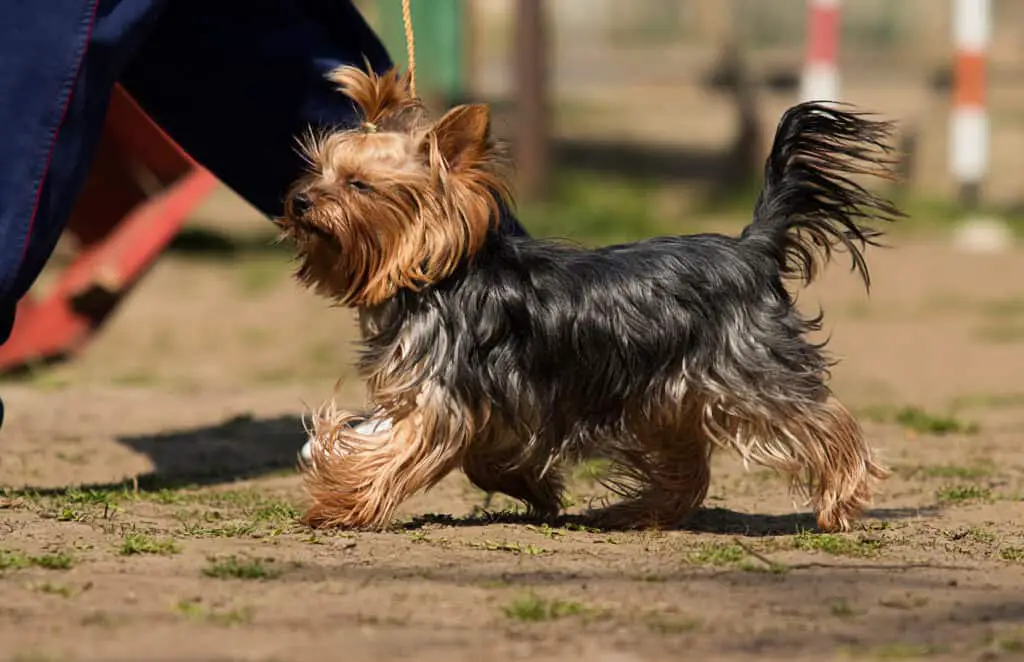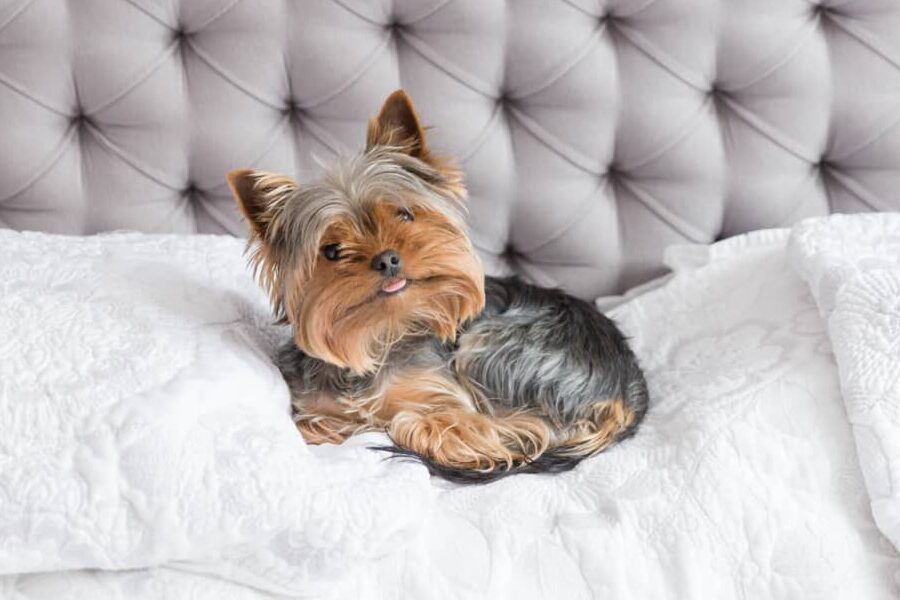Affiliate Disclosure: This post may contain affiliate links. If you make a purchase after clicking on these links I will be compensated at no extra cost to you. However, I never recommend anything I don’t love or wouldn’t use myself!
Yorkies are excellent dogs, particularly for anyone living in a smaller home. However, when bringing any new dog home, you need to be prepared to house train them.
Yorkies are notoriously hard to housebreak. They are territorial, have small bladders, and often experience separation anxiety. All of these factors can make house training more challenging. However, with proper technique and patience, they can be housebroken with relative ease.
Don’t let the breed’s potty training reputation discourage you. With the right techniques, you should have no real issues. In this article, you will learn the best potty training techniques to make the process as simple as possible.
The Difficulties of Housebreaking a Yorkie
While Yorkies are infamously difficult to potty train, no dog is untrainable. No matter the breed, every dog requires plenty of patience, practice, and perseverance to be successfully housebroken. In my opinion, Yorkies are definitely worth the trouble.
Small Dog, Small Bladder…
Yorkies are part of the toy dog variety. Their smaller size means they also have a smaller bladder. This means they will need more frequent trips to the restroom than larger breeds.
The positive side to this is that if your Yorkie does have an accident, it’s much easier to take care of than larger breeds!
You should be aware, however, Yorkshire Terriers are fairly prone to experiencing separation anxiety. Dogs with separation anxiety may struggle to hold their pee when left alone.
Although, this was not the case in my experience. Once my female Yorkie had mastered training, she very rarely went to the toilet inside the house, even if I was out at work all day.
Small Dog Syndrome
While a small dog has a small bladder, the same does not apply to its larger-than-life attitude. Like other small dogs, Yorkies tend to be rather sassy and can be quite territorial. This can make training a little more difficult in some cases.
A fellow Yorkie owner explained that their seven-year-old male Yorkie still occasionally goes inside the house. However, this negative behavior only occurred when the Yorkie was left alone for too long, was upset with his owners, or was agitated by large groups of people.
This is an example of territorial marking which can be more common among male Yorkies but can also occur with females.
How Long Does It Take To Potty Train a Yorkie?
It takes less than 4 months to potty train a Yorkie. However, for Yorkies that have received intensive training, it can be much sooner. It’s worth noting that Yorkies from a pet store are more likely to struggle with potty training compared to those from a breeder.
Yorkies that have begun training at the recommended age can be expected to be fully housebroken by the age of 6 or 7 months.
Yorkie puppies older than seven months that still struggle with potty training should visit the veterinarian or a dog trainer. Some dogs may urinate frequently due to a medical condition.
When Should You Start to Potty Train a Yorkie?
Potty training in Yorkies should begin by 12 to 16 weeks of age. At this time Yorkies should have the faculties to hold their waste for 2 hour periods. Additionally, they should have had the necessary vaccinations to start going outside if this is where you intend to train them.
If you are adopting a puppy it’s best to start potty training your Yorkie as soon as you bring them home.
Introducing younger Yorkie puppies to the concept of using a designated area via the use of puppy pads or newspapers, can help speed up the process later on. Just don’t expect to see any solid results before around 12 weeks.
How to Potty Train a Yorkie? 9 Tips and Techniques

Now that you know more about the difficulties and timescale for potty training a Yorkie, here are 8 useful tips that will simplify and speed up the process.
1. Schedule Potty Breaks
Avoiding incidents means not waiting for your puppy to signal they need to use the bathroom. Untrained Yorkies are extremely unlikely to let you know when it’s time to go!
For this reason, you need to schedule specific times to take them outside to go potty. Set up reminders on your phone at least once every two hours, to begin with.
Overnight while your Yorkie is sleeping they should be okay to hold it a bit longer but you will likely have to let them out at least once or twice, to begin with.
Also, make sure to take your puppy immediately after waking up and right before going to bed. The frequent repetition will teach your puppy that all bathroom activities should take place outside.
Over time, you can extend the time between pee breaks. A fully grown adult can wait up to 6 or 8 hours. Possibly even longer, although this is not recommended, especially not regularly.
2. Establish a Feeding Routine
If your Yorkie gets fed at regular intervals every day, they are more likely to want the bathroom at regular intervals also. Therefore, scheduled feeding times make their potty habits more predictable and easier to monitor.
Additionally, when your Yorkie fills up its little belly, it will likely have the urge to go to the bathroom shortly after, making this is the perfect time to take them.
Ideally, you should integrate toilet breaks into their schedule around 20 mins after feeding times.
3. Pick a Potty Spot and Use a Leash
It’s no secret that puppies love to investigate and play. Often, the interaction with their owners and going outside will signal to them that it’s playtime.
Therefore, putting them on a leash and taking them to the same spot each time you want them to go to the toilet will help avoid any confusion.
4. Use a Specific Verbal Command
Pick a specific command such as “wee-wee” or “go potty” to use whenever you want your puppy to eliminate waste.
To begin with, you should repeat the command even while they are already mid-flow to help them make the connection between their actions and your words.
Eventually, with enough repetition, they will learn to understand your requests.
5. Reward Them Appropriately
As with any type of training, rewards and praise are absolutely paramount in getting your dog to behave the way that you want it to.
Be sure to continue using your chosen voice commands and then reward them with a treat while you shower them with praise whenever they do a good job.
Your puppy will soon learn to associate a successful elimination of waste with the subsequent treats and praise, so they will want to repeat their actions in the future.
6. Supervise Constantly and Try to Pre-Empt Accidents
Potty training a new puppy is a full-time job, ideally, they should be watched 24/7. Understandably, this is not feasible for most owners. Nonetheless, you need to keep an extremely close eye as much as is reasonably possible.
Whenever you see them readying up to go to the toilet or even if they are already mid-potty, firmly but calmly say “no.” Remove them from the situation as quickly as possible, taking them to their designated potty spot.
Do not get angry and do not try to correct your dog by rubbing their nose in it! This will teach them nothing, other than to fear you and to hide away from you when it’s time to go.
Stay calm and if they manage to finish up in the correct area then you should reward them as usual.
7. Clean Up Thoroughly After Mishaps
If and when mistakes happen, be sure to clean the area thoroughly.
Dogs typically have a strong desire to use areas that already smell like urine or feces. Even the slightest residue can be picked up by a Yorkies keen sense of smell and will encourage them to repeat the offense in the same spot.
Your may find that using a stain and odor remover such as this one on Amazon can help with this.
8. Reduce Liquid Intake Before Bed Time
If your puppy has troubles at nighttime then you can try removing their water bowl around 2 hours before turning in for the night. Make sure that they have had a drink beforehand though as you don’t want them to be thirsty.
This will give them a much better chance at lasting the night and will reduce the risk of them developing bad habits while you are not around.
Just be sure to return the water first thing in the morning and that they get plenty of water throughout the day.
9. Use a Crate When You Are Not Around
No matter which trainer you speak to, they will likely recommend crate training. It’s a great tool for many reasons. Aside from helping to reduce anxiety, especially for dogs who have just been rehomed, crate training can also help with potty training. Particularly at nighttime or times when you have to leave your puppy alone.
Why is this technique so effective? Dogs try to keep their sleeping spaces clean. When they are not able to leave their sleeping area, they must hold their bladder. Not only does this prevent them from peeing throughout the house, but it helps strengthen their bladder muscles.
Find the Perfect Crate
Find your puppy a crate large enough so they can just stand up and turn around in it. The crate shouldn’t be too big or it won’t be as effective in reducing anxiety, or for potty training.
If your puppy is still growing, you could consider using a divider panel to temporarily adjust the size of the crate. This fully equipped crate on Amazon includes a divider panel and is perfect for the average-sized Yorkie.
Crate training tips
Your Yorkie will likely cry for the first few nights in their crate but this is normal. Puppies are used to sleeping with their mom and their siblings. Spending the night in an unfamiliar place without them will be tough. As heartbreaking as it might be though, they will soon adjust so stick with it.
I would strongly recommend using an old blanket or towel inside their crate until they are fully potty trained. Even though a crate will reduce the chances of your pup fowling in the first place, accidents can and probably will still happen.
A blanket or towel is much easier to wash. It’s also more easily replaceable than a fitted bed. Often these beds will be obstructed by divider panels while your puppy is growing anyway.
Do not leave your puppy in the crate for too long and do not use the crate as a form of punishment. Bear in mind the crate should be a place of safety and comfort. Always encourage or entice them into the crate with treats rather than forcing them in.

